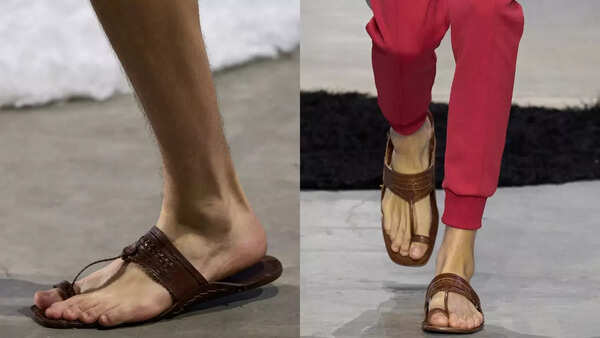Prada has finally recognized the influence of traditional Indian footwear on its new sandal design, following criticism for initially failing to credit the Kolhapuri chappal.

The Italian fashion house showcased its Spring-Summer 2026 men's collection, which included sandals that bore a striking resemblance to Kolhapuri chappals, the iconic handmade leather footwear from Maharashtra, India. However, the brand's show notes only referred to them as "leather sandals," omitting any mention of the traditional Indian inspiration.
This omission sparked outrage among fashion observers in India.
Lalit Gandhi, president of the Maharashtra Chamber of Commerce, Industry and Agriculture, was among the first to publicly address the issue. He emphasized that Kolhapuri chappals are not simply ordinary sandals; they possess significant cultural and artisanal value. Notably, Kolhapuri chappals received a Geographical Indication (GI) tag in 2019, further underscoring their unique regional origin and craftsmanship.
In response to the criticism, Lorenzo Bertelli, head of CSR at the Prada Group, sent a letter to Gandhi acknowledging the inspiration behind the sandal design. Bertelli admitted that the design was indeed influenced by traditional Indian handcrafted footwear, recognizing its "centuries-old heritage." He clarified that the collection is still in the early design phase and has not yet been produced or offered for sale.
Bertelli also expressed Prada's respect for Indian craftsmanship and its interest in exploring collaborations with local artisans in the future.
While Prada's acknowledgment is a welcome step, Gandhi's original point remains critical: cultural exchange in fashion requires proper credit and collaboration. It is not enough to simply "borrow" designs; it is essential to recognize the origins of these designs and support the communities that have preserved these traditions.
If this incident leads to major brands genuinely supporting traditional crafts instead of merely repackaging them, it could represent a positive shift for the fashion industry.
Newer articles
Older articles
 Cervical Cancer: Don't Ignore These 5 Subtle Warning Signs
Cervical Cancer: Don't Ignore These 5 Subtle Warning Signs
 Bezos-Backed Methane-Tracking Satellite Suffers Mission-Ending Failure in Orbit
Bezos-Backed Methane-Tracking Satellite Suffers Mission-Ending Failure in Orbit
 Rishabh Pant's Revolutionary Cricket Reshaping the Game, Says Greg Chappell
Rishabh Pant's Revolutionary Cricket Reshaping the Game, Says Greg Chappell
 Bangladesh Test Captain Najmul Hossain Shanto Resigns After Sri Lanka Defeat
Bangladesh Test Captain Najmul Hossain Shanto Resigns After Sri Lanka Defeat
 Greg Chappell Hails Rishabh Pant's 'Game-Changing' Batting Display Against England
Greg Chappell Hails Rishabh Pant's 'Game-Changing' Batting Display Against England
 Colon Cancer: 5 Subtle Warning Signs You Shouldn't Ignore
Colon Cancer: 5 Subtle Warning Signs You Shouldn't Ignore
 Gujarat Cricket Association Set to Debut T20 League in 2025-26 Season
Gujarat Cricket Association Set to Debut T20 League in 2025-26 Season
 England Captain Stokes Praises Opening Duo After Record-Breaking Chase Against India
England Captain Stokes Praises Opening Duo After Record-Breaking Chase Against India
 'The Traitors' Star Apoorva Mukhija Accuses Sudhanshu Pandey of Abusive Language, Misogyny Following Show's Finale
'The Traitors' Star Apoorva Mukhija Accuses Sudhanshu Pandey of Abusive Language, Misogyny Following Show's Finale
 Bangladesh's Shadman Islam Rallying Behind Teammates After Day 1 Batting Woes vs. Sri Lanka
Bangladesh's Shadman Islam Rallying Behind Teammates After Day 1 Batting Woes vs. Sri Lanka